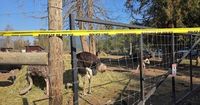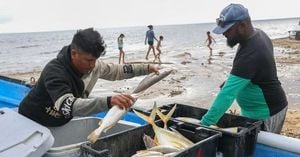On the evening of November 6, 2025, a quiet rural corner of Edgewood, British Columbia, became the unlikely focus of international attention as gunshots rang out from Universal Ostrich Farms. The shots marked the end of a ten-month legal and political saga that pitted a determined family of ostrich farmers against the full force of Canadian federal policy, and drew in a cast of characters as varied as U.S. Health Secretary Robert F. Kennedy Jr., celebrity doctor Mehmet Oz, and New York billionaire John Catsimatidis.
The Canadian Food Inspection Agency (CFIA) announced on November 7 that all ostriches at the farm—numbering between 300 and 330—had been killed, fulfilling a cull order issued after a bird flu outbreak was detected nearly a year earlier. The operation was carried out by professional marksmen in a controlled, on-farm setting, and, according to the CFIA, was supervised by veterinarians to ensure it was as humane as possible. The agency stated, “This method is consistent with Canadian Veterinary Medical Association and American Veterinary Medical Association recommendations and may be used as required, particularly when other methods are impractical.”
The cull was not a quiet affair. As darkness fell and the first shots echoed from the hay bale enclosure where the ostriches had been herded, supporters of the farm gathered outside, chanting and shouting their disapproval. Some, according to BBC, yelled, “Stop!” and “Murderers!” Others wept openly, holding hands in the rain. Farm spokeswoman Katie Pasitney, whose mother Karen Espersen co-owns the property, later posted on Facebook, “We are broken and can’t imagine the suffering last night. We can’t get out of bed.”
The farm’s owners had fought the cull for months, arguing that their ostriches were healthy and had developed “herd immunity” after the initial outbreak, which killed 69 birds. They insisted that the flock was valuable for scientific research and pleaded for the birds to be tested for infection rather than destroyed. The CFIA, however, refused. The agency cited the risk that apparently healthy birds could still harbor the virus and potentially spread or mutate it, posing a threat not just to animal health, but to Canada’s $6.8 billion poultry industry and its $1.75 billion in exports. “Our disease response aims to protect both public and animal health, as well as minimize impacts on the domestic poultry industry and the Canadian economy,” the CFIA stated, as reported by National Post.
The legal battle reached all the way to the Supreme Court of Canada, which on the morning of November 6, 2025, declined to hear the farm’s final appeal, clearing the last hurdle to the cull. Lower courts had previously sided with the federal agency, ruling that it had acted reasonably and fairly in applying its “stamping out” policy for avian flu. The farm remained quarantined under the Health of Animals Act, and RCMP officers were present during the cull to maintain order. No injuries or arrests were reported, but the tension was palpable as officers blocked access roads and turned away supporters, according to Global News.
The ostrich cull quickly became a lightning rod for broader debates about government authority, public health, and animal welfare. The story attracted a surprising roster of high-profile supporters from both sides of the U.S.-Canada border. U.S. Health Secretary Robert F. Kennedy Jr. sent a letter to the president of the CFIA urging reconsideration, writing, “There is significant value in studying this population, instead of the indiscriminate killing of the flock.” Dr. Mehmet Oz, now an administrator of the Centers for Medicare & Medicaid Services, offered to relocate the birds to his Florida ranch. New York billionaire John Catsimatidis called for a “thorough investigation” and suggested the U.S. Department of Justice should step in if Canada did not. Despite their efforts, Canadian officials stood firm.
Locally, the cull divided the community of Edgewood. Some residents and local businesses complained about confrontations with the farm’s supporters, who had set up camp on the property. The issue even drew in Canadian anti-mandate activists, such as Tamara Lich, who helped fundraise for the farm’s legal defense. The farm’s owners and their supporters accused the government of overreach, while others in the region worried about the economic and health risks posed by the avian flu. BC Conservative MP Scott Anderson, a supporter of the farm, criticized what he called a “poorly executed operation,” claiming it had “cost Canadians millions of dollars, hundreds of hours of RCMP overtime, and has turned the once peaceful town of Edgewood into something that looks like a science fiction movie set featuring Area 51.”
Canadian federal officials, for their part, remained largely silent in public. Prime Minister Mark Carney did not comment, but Justice Minister Sean Fraser told reporters he was “pleased to see” the top court’s dismissal of the case, stating, “It’s important that the minister of agriculture and CFIA are able to protect the health of the general Canadian public and the food we consume.”
As dawn broke on November 7, the scene at Universal Ostrich Farms was somber. The pen where the ostriches had been held was empty, covered with long blue tarpaulins and black sheeting. Only the hum of generators and the presence of a lone RCMP officer broke the silence, as reported by Canadian Press. The CFIA began the “disposal stage” of the operation, with carcass removal underway. The farm’s owners, though devastated, were eligible for compensation of up to 3,000 Canadian dollars (about 2,136 USD) per ostrich, according to the CFIA.
For many, the ostrich cull in Edgewood was more than a response to an outbreak—it became a flashpoint in ongoing debates about public health policy, government power, and the value of animal life. As supporters and opponents continue to voice their opinions, the fields of Universal Ostrich Farms stand empty, a stark reminder of the high stakes at the intersection of science, law, and community.






